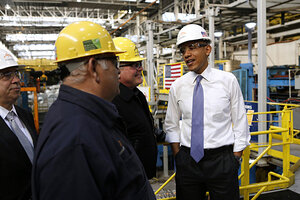Eager to change subject, Obama touts healthy energy progress
President Obama toured a steel plant in Cleveland to highlight job growth in the auto industry and pointed to one area where the US is making advances: energy.

President Obama tours the ArcelorMittal steel mill in Cleveland Thursday. In a speech at the factory, Mr. Obama pointed to energy efficiency and energy independence as areas where the US has made progress.
Kevin Lamarque/Reuters
President Obama's signature health-care program is stumbling out of the gate. Lawmakers are scrutinizing overseas spying operations. A deal on Iran's nuclear plan has yet to materialize.
After weeks of discussing glitches and setbacks, Mr. Obama tried to change the subject in Cleveland Thursday. He toured a steel plant to highlight job growth in the auto industry, which just five years ago was on the verge of collapse. And he pointed to one area where the United States has seen some progress: energy.
"We [have] invested in new American technologies to reverse our addiction to foreign oil, double wind power, double solar power, produce more oil, produce more natural gas, and do it all in a way that is actually bringing down some of our pollution, making our entire economy more energy-efficient," the president said in a speech at the factory.
The energy intensity of the US economy – total energy consumption per unit of gross domestic product – has been dropping for some time: 58 percent per real dollar of GDP between 1950 and 2011, according to the US Energy Information Administration. And it's projected to continue to decline over the coming decades. Energy consumption per person began a steady decline in 2007, in part because of new appliance and fuel-economy standards passed during the Obama administration.
Houses are 30 percent larger today than those built prior to 2000 and contain about 18 percent more appliances, electronics, and lighting. Nevertheless, they consume only 2 percent more energy on average because energy-hogging appliances like refrigerators and washing machines have gotten dramatically more efficient. Better windows, walls, and thermostats are using less energy to keep occupants cool in the summer and warm in the winter.
The average US car could drive 23.8 miles on a single gallon of gas in 2012, according to projections from the Environmental Protection Agency. That's up 1.4 miles from 2011 – the single largest increase since the EPA started keeping records in 1975. Back then, the average US car could get 13.1 miles on a gallon, less than half of today's fuel economy.
ArcelorMittal, the steelmaker that Obama toured Thursday, has played a role in automotive efficiency. The Luxemborg-based company makes advanced high-strength steels to build lighter cars. The company says its energy-efficient Cleveland factory is one of the most productive steelmaking facilities in the world, based on employee hours per ton of steel produced.
"[T]his plant, if it’s located in Germany, energy costs are double, maybe triple; same in Japan," Obama said. "So this gives us a big edge."
The Obama administration has toughened decades-old fuel efficiency standards, increasing fuel economy targets to the equivalent of 54.5 mpg for cars and light-duty trucks by model year 2025. In August, the Department of Energy proposed two new efficiency rules on commercial refrigeration equipment and walk-in coolers and freezers. Those rules could cut energy bills by up to $28 billion and cut emissions by over 350 million metric tons of carbon dioxide over 30 years, according to government estimates.

